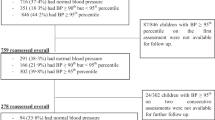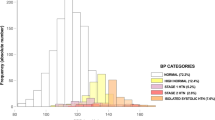Abstract
Despite the association of childhood blood pressure (BP) with hypertension later in the life course, there remains dearth of information regarding the prevalence and emergence of hypertension in children, especially in China. To investigate the current status of BP, prevalence of elevated BP and related factors in Chinese children, a cross-sectional survey in a representative sample of 9354 Chinese children 5–17 years old was conducted in seven cities in Northeastern China during 2011 and 2012. BP measurements were taken by mercury sphygmomanometer. Elevated BP in children was defined as an average diastolic BP or systolic BP that is in the 95th percentile or higher for their gender, age and height. Overall, total prevalence of elevated BP was 13.8%, and no significant difference between males and females was identified. Multivariate analyses revealed that children having a higher area of residence had a lower of elevated BP. Increased odds for elevated BP were found for individuals who were lean (odds ratio (OR)=2.12; 95% confidence interval (CI): 1.67–2.69), overweight (OR=2.05; 95% CI: 1.74–2.42), obese (OR=3.15; 95% CI: 2.70–3.68), were born with low birth weight (OR=1.26; 95%CI: 1.01–1.63), premature birth (OR=1.46; 95%CI: 1.13–1.88), and were with home coal use (OR=1.24; 95%CI: 1.02–1.52). In conclusion, elevated BP was found to be prevalent in children in urban areas of Northeast China. These results underscore the importance of implementing a package of measures aimed at reducing malleable risk for this cardiovascular condition in school-aged children in Northeast China.
This is a preview of subscription content, access via your institution
Access options
Subscribe to this journal
Receive 12 digital issues and online access to articles
$119.00 per year
only $9.92 per issue
Buy this article
- Purchase on Springer Link
- Instant access to full article PDF
Prices may be subject to local taxes which are calculated during checkout
Similar content being viewed by others
References
Danaei G, Singh GM, Paciorek CJ, Lin JK, Cowan MJ, Finucane MM et al. The global cardiovascular risk transition: associations of four metabolic risk factors with national income, urbanization, and Western diet in 1980 and 2008. Circulation 2013; 127: 1493–1502.
Danaei G, Finucane MM, Lin JK, Singh GM, Paciorek CJ, Cowan MJ et al. National, regional, and global trends in systolic blood pressure since 1980: systematic analysis of health examination surveys and epidemiological studies with 786 country-years and 54 million participants. Lancet 2011; 377: 568–577.
Kearney PM, WheltonM, Reynolds K, MuntnerP, Whelton PK, He J . Global burden of hypertension: analysis of worldwide data. Lancet 2005; 365: 217–223.
Ahern D, Dixon E . Pediatric hypertension: a growing problem. Prim Care 2015; 42: 143–150.
Chen X, Wang Y . Tracking of blood pressure from childhood to adulthood: a systematic review and meta-regression analysis. Circulation 2008; 117: 3171–3180.
Hansen ML, Gunn PW, Kaelber DC . Underdiagnosis of hypertension in children and adolescents. JAMA 2007; 298: 874–879.
National High Blood Pressure Education Program Working Group on High Blood Pressure in Children and Adolescents. The fourth report on the diagnosis, evaluation, and treatment of high blood pressure in children and adolescents. Pediatrics 2004; 114: 555–576.
de Moraes AC, Carvalho HB, Siani A, Barba G, Veidebaum T, Tornaritis M et al. Incidence of high blood pressure in children—effects of physical activity and sedentary behaviors: the IDEFICS Study: High blood pressure, lifestyle and children. Int J Cardiol 2015; 180: 165–170.
McNiece KL, Poffenbarger TS, Turner JL, Franco KD, Sorof JM, Portman RJ . Prevalence of hypertension and pre-hypertension among adolescents. J Pediatr 2007; 150: 640–644.
Sorof JM, Lai D, Turner J, Poffenbarger T, Portman RJ . Overweight, ethnicity, and the prevalence of hypertension in school-aged children. Pediatrics 2004; 113: 475–482.
Dong GH, Qian ZM, Trevathan E, Zeng XW, Vaughn MG, Wang J et al. Air pollution associated hypertension and increased blood pressure may be reduced by breastfeeding in Chinese children: the Seven Northeastern Cities Chinese Children's Study. Int J Cardiol 2014; 176: 956–961.
Chiolero A, Cachat F, Burnier M, Paccaud F, Bovet P . Prevalence of hypertension in schoolchildren based on repeated measurements and association with overweight. J Hypertens 2007; 25: 2209–2217.
World Health Organization Physical Status: The Use and Interpretation of Anthropometry. WHO: Geneva, Switzerland, 1995.
National Center for Chronic Disease Prevention and Health Promotion, Centers for Disease Control and Prevention BMI: Body Mass Index. Centers for Disease Control and Prevention: Atlanta, GA, 2002. World Wide Web URL http://www.cdc.gov/nccdphp/dnpa/bmi Accessed on January 27, 2012.
Jafar TH, Islam M, Poulter N, Hatcher J, Schmid CH, Levey AS et al. Children in South Asia have higher body mass-adjusted blood pressure levels than white children in the United States: a comparative study. Circulation 2005; 111: 1291–1297.
Kelishadi R, Ardalan G, Gheiratmand R, Majdzadeh R, Delavari A, Heshmat R et al. Blood pressure and its influencing factors in a national representative sample of Iranian children and adolescents: the CASPIAN Study. Eur J Cardiovasc Prev Rehabil 2006; 13: 956–963.
Monyeki KD, Kemper HC, Makgae PJ . The association of fat patterning with blood pressure in rural South African children: the Ellisras Longitudinal Growth and Health Study. Int J Epidemiol 2006; 35: 114–120.
Chiolero A, Madeleine G, Gabriel A, Burnier M, Paccaud F, Bovet P . Prevalence of elevated blood pressure and association with overweight in children of a rapidly developing country. J Hum Hypertens 2007; 21: 120–127.
Schwandt P, Bertsch T, Liepold E, Haas GM . Age- and gender-specific components of the metabolic syndrome in 2228 first graders: The PEP Family Heart Study. Scientifica 2013; 2013: 394807.
Paradis G, Lambert M, O’Loughlin J, Lavallee C, Aubin J, Delvin E et al. Blood pressure and adiposity in children and adolescents. Circulation 2004; 110: 1832–1838.
Genovesi S, Giussani M, Pieruzzi F, Vigorita F, Arcovio C, Cavuto S et al. Results of blood pressure screening in a population of school-aged children in the province of Milan: role of overweight. J Hypertens 2005; 23: 493–497.
Khang YH, Lynch JW . Exploring determinants of secular decreases in childhood blood pressure and hypertension. Circulation 2011; 124: 397–405.
Buch N, Goyal JP, Kumar N, Parmar I, Shah VB, Charan J . Prevalence of hypertension in school going children of Surat city, Western India. J Cardiovasc Dis Res 2011; 2: 228–232.
Yong LC, Kuller LH . Tracking of blood pressure from adolescence to middle age: the Dormont High School Study. Prev Med 1994; 23: 418–426.
Lauer RM, Clarke WR . Childhood risk factors for high adult blood pressure: the Muscatine Study. Pediatrics 1989; 84: 633–641.
Juonala M, Magnussen CG, Berenson GS, Venn A, Burns TL, Sabin MA et al. Childhood adiposity, adult adiposity, and cardiovascular risk factors. N Engl J Med 2011; 365: 1876–1885.
August GP, Caprio S, Fennoy I, Freemark M, Kaufman FR, Lustig RH et al. Prevention and treatment of pediatric obesity: an Endocrine Society clinical practice guideline based on expert opinion. J Clin Endocrinol Metab 2008; 93: 4576–4599.
Bergvall N, Iliadou A, Tuvemo T, Cnattingius S . Birth characteristics and risk of high systolic blood pressure in early adulthood: socioeconomic factors and familial effects. Epidemiology 2005; 16: 635–640.
Lurbe E, Garcia-Vicent C, Torro MI, Aguilar F, Redon J . Associations of birth weight and postnatal weight gain with cardiometabolic risk parameters at 5 years of age. Hypertension 2014; 63: 1326–1332.
Luyckx VA, Bertram JF, Brenner BM, Fall C, Hoy WE, Ozanne SE et al. Effect of fetal and child health on kidney development and long-term risk of hypertension and kidney disease. Lancet 2013; 382: 273–283.
Daly B, Scragg R, Schaaf D, Metcalf P . Low birth weight and cardiovascular risk factors in Auckland adolescents: a retrospective cohort study. N Z Med J 2005; 118: U1612.
Kalies H, Heinrich J, Borte N, Schaaf B, von Berg A, von Kries R et al. The effect of breastfeeding on weight gain in infants: results of a birth cohort study. Eur J Med Res 2005; 10: 36–42.
Huus K, Ludvigsson JF, Enskär K, Ludvigsson J . Exclusive breastfeeding of Swedish children and its possible influence on the development of obesity: a prospective cohort study. BMC Pediatr 2008; 8: 42.
Kramer MS, Matush L, Vanilovich I, Platt RW, Bogdanovich N, Sevkovskaya Z et al. Effects of prolonged and exclusive breastfeeding on child height, weight, adiposity, and blood pressure at age 6.5 y: evidence from a large randomized trial. Am J Clin Nutr 2007; 86: 1717–1721.
Baumgartner J, Schauer JJ, Ezzati M, Lu L, Cheng C, Patz JA et al. Indoor air pollution and blood pressure in adult women living in rural China. Environ Health Perspect 2011; 119: 1390–1395.
Smith KR, Mehta S, Maeusezahl-Feuz M Indoor smoke from household solid fuels. In: Ezzati M, Lopez AD, Rodgers A, Murray CJL (eds). Comparative Quantification of Health Risks: Global and Regional Burden of Disease Attributable to Selected Major Risk Factors. World Health Organization, Geneva, 2004, 1435–1493.
Brook RD, Bard RL, Burnett RT, Shin HH, Vette A, Croghan C et al. Differences in blood pressure and vascular responses associated with ambient fine particulate matter exposures measured at the personal versus community level. Occup Environ Med 2011; 68: 224–230.
Acknowledgements
We appreciate the cooperation from school principals, teachers and students and their parents in the seven cities. This work was supported by Grants from China Environmental Protection Foundation (CEPF2008–123–1–5), the Liaoning Province Science and Technology Foundation (2013225049), and the Guangdong Province Natural Science Foundation (2014A050503027). This research was supported by grants from China Environmental Protection Foundation (CEPF2008–123–1–5), the Liaoning Province Science and Technology Foundation (2013225049), and the Guangdong Province Natural Science Foundation (2014A030313021).
Author information
Authors and Affiliations
Corresponding author
Ethics declarations
Competing interests
The authors declare no conflict of interest.
Rights and permissions
About this article
Cite this article
Zhou, Y., Qian, Z., Vaughn, M. et al. Epidemiology of elevated blood pressure and associated risk factors in Chinese children: the SNEC study. J Hum Hypertens 30, 231–236 (2016). https://doi.org/10.1038/jhh.2015.104
Received:
Revised:
Accepted:
Published:
Issue Date:
DOI: https://doi.org/10.1038/jhh.2015.104
This article is cited by
-
Association between high birth weight and hypertension in children and adolescents: a cross-sectional study in China
Journal of Human Hypertension (2017)
-
Weight status, cardiorespiratory fitness and high blood pressure relationship among 5–12-year-old Chinese primary school children
Journal of Human Hypertension (2017)
-
Epidemiological studies in hypertension: more relevant than ever
Journal of Human Hypertension (2016)
-
Birth Weight and Birth Weight for Gestational Age in Relation to Risk of Hospitalization with Primary Hypertension in Children and Young Adults
Maternal and Child Health Journal (2016)



